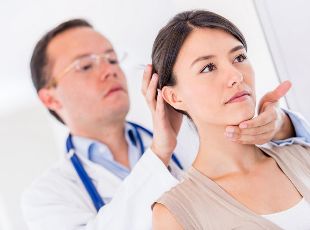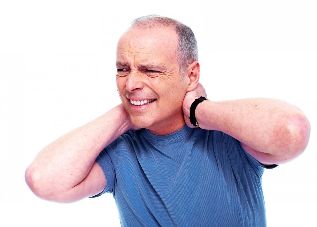Like other back diseases, 1st degree cervical fibroids are characterized by the presence of pain. The nature of the pain can be called tolerable, but this has no reason for you to recover without further medical examination and treatment. Ignoring symptoms of osteonecrosis, still in stage 1, can lead to the patient's condition worsening and further development of the disease.
Self-treatment is not recommended, only an experienced doctor can make an accurate diagnosis, identify the cause of the symptoms of the disease and make clear recommendations for dealing with osteonecrosis.
Cause of the disease
In the context of 1st degree osteoporosis of the cervical spine, first of all, there are pains of a shooting nature, called lumbago. Pain syndrome occurs in the cervical area, severe cases extend to the shoulder, arm and chest muscles. This occurs because the disc tend to be injured to a greater degree when the moving part of the spine (neck area) is connected to the less mobile, thoracic region.

The cervical region consists of 7 vertebrae. The two head sections support the skull, which is why a person can rotate the head, tilt it and lift it up. The vertebrae are connected by movable joints and ligaments, and the disc, including cartilage tissue, acts as a cushion between the vertebrae. The side muscles are also designed to keep the spine in an upright position, if the corset is well developed then the spine will be stable. As you can see, the rhythmic coordination of the vertebrae, disc and muscles ensures a healthy spinal function. As soon as a link from this system begins to malfunction, a disturbance occurs in the entire work of the spine.
For whatever reasons there are possible violations and the first symptoms of osteonecrosis appear:
- sedentary lifestyle;
- excessive physical activity;
- incorrect position when sleeping;
- diet does not provide the body with enough quality to help strengthen the skeletal and muscle systems;
- bad habit;
- stress;
- lack of adequate rest, fatigue;
- suffer from frequent hypothermia and colds.
If the muscles that support the spine in a stable position begin to age and lose tone by the age of 50, this may be considered normal. But when the cervical vertebrae undergoes deformation at the age of 20, it needs attention and implementation. Get preventive treatment, exercise, live an active lifestyle, and avoid sedentary work with a bent neck and back.
Symptoms
In order to list the main signs and symptoms that one can accurately identify grade 1 fibroids, it is necessary to clarify this concept.
Grade 1 fibroids are an early stage of the disease, characterized by compression of the cartilaginous tissue of the intervertebral disc between the vertebrae. The spine remains in a stable position, but the hook-shaped processes of the vertebrae have gradually increased in size. The displacement of the disc is minimal, but its outer shell, including fibrous tissue, begins to disturb which, if left untreated, can lead to the development of degenerative levelsbones follow and even lead to disc herniation.
The main symptoms of necrosis of the cervical spine:
- Pain syndrome
- begins in the neck area, spreading to the shoulder joint, shoulder blade and chest muscle;
- compression of nerve ends leads to pain like rotation in the neck, especially this condition is exacerbated when sleeping with an uncomfortable position, at night, the patient after waking up keeps the neck inunnatural posture for long periods due to inability to turn head without pain;
- in the context of pinched nerve roots, heart syndrome can occur - pain in the chest muscles confusing the patient with a heart attack (examination does not confirm the presence of heart disease);
- due to spinal artery syndrome, impaired blood supply to the brain and spinal cord, causing headaches, visual disturbances in the "fly in the eye" style, dizziness, occipital pain;
- sleep disturbance;
- worry.

Pain syndrome accompanied by muscle spasm in the affected spinal area. Bone tumors of grade 1 spine may not cause the symptoms clearly listed, it all depends on the body's sensitivity to pain and the patient's general condition.
With constant fatigue, sedentary work and stress, any symptoms of the disease are perceived more deeply. Therefore, the first sign of osteonecrosis - pain in the neck, especially after exertion or hypothermia - should be a reason to seek medical attention.
Treatment and prevention
Treatment for degenerative spondylolisthesis 1 should, first of all, aim to eliminate pain syndrome and initiate active metabolic processes in the tissue of the disc. In addition, it is necessary to strengthen the neck skeleton to maintain the spine in a stable, stable position.
Drug therapy includes the following methods:
- pain reliever, anti-inflammatory drug;
- physiotherapy;
- massage;
- acupuncture;
- medical gymnastics;
- swim.
With the help of drug treatment, it is necessary to relieve pain and inflammation to the affected area, in this case, the doctor may combine an anesthetic with an injection of vitamins, anti-inflammatory drugs. A good effect is achieved when using external agents in the form of a warming gel based on pain relievers, as well as bee and snake venom.
In addition to drug and physical therapy, there can be therapeutic exercises that gently stretch the spine, release pinched nerve roots, and relieve neck pain. The next preventive measures are healthy lifestyle, active, sports, good nutrition, and avoiding stress and hypothermia.

























